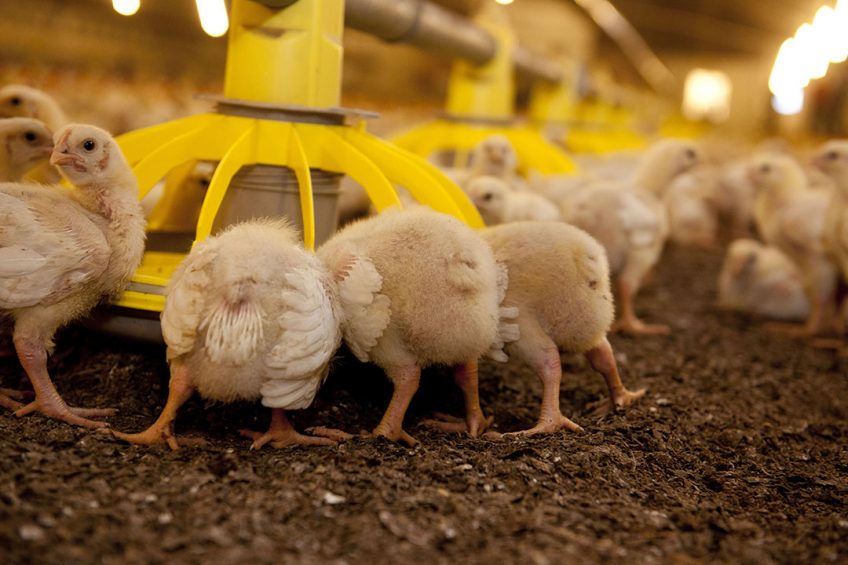Gut health: Reducing antibiotic use in poultry production

In recent years pressure to reduce on farm antibiotic usage has been mounting, with retailers now monitoring farmers’ performance and antibiotic growth promoters banned in the EU. As we move towards antibiotic reduction in agriculture, it is becoming increasingly important to promote gut health and target disease challenges in other ways.
Broiler production focuses on obtaining a low feed conversion ratio alongside a high growth rate, while breeders and layers focus on the number of viable hatching eggs per bird or eggs per bird. Whichever production method is used the intrinsic link between bird quality and performance is gut health. In simple terms a healthy gastrointestinal (GI) system is one which ensures that birds can sustainably digest and absorb the maximum amount of nutrients from their feed and are therefore able to use these nutrients for growth or egg production.
Many factors can influence the effectiveness of this process including:
- a balanced gut microbiota,
- disease pressure,
- villi length and surface area,
- crypt depth,
- mucosal immunity and
- the thickness of the mucous layer lining the gut
Key to good gut health
When presented with a disease challenge much of the metabolic energy that could have been put towards growth or egg production will be diverted to modulating immune response and fighting the infection. Maintaining good gut health in the flock will minimise disruption to production caused by disease challenges and ensure that the need for antibiotics is lessened. The key to good gut health is microbiome diversity.

Gut Health Special:
Managing gut health is very complex with many parameters to consider. This special section contains articles highlighting specie-specific topics.
Microbiome diversity matters
A bird’s microbiome consists of all the micro-organisms found in the GI tract, be they bacteria, fungi or protozoa. These organisms interact to form an environment which is unique to that bird, in the same way that the rainforest is its own delicate ecosystem. Having greater species diversity present is beneficial for the bird in many ways. The microbiome is made up of ‘foreign’ organisms that are recognised by the immune system and which then educate it, thus having an influence on the type and intensity of the bird’s response to those organisms in the future. Having more and a greater variety of micro-organisms creates a stronger and more stable immune system, meaning that birds will be able to cope better with disease pressure and stress when it occurs. Improving the microbial diversity of the gut ensures that there is competition between bacterial species for resources in the bird and thus species that are not in an optimum environment will not be able to grow or replicate as efficiently. Having a wide variety of beneficial organisms present – each competing in a different niche – means that pathogenic bacteria are less likely to be able to flourish. It could be thought of in the same sense as a population of people in a village where diversity is the number of different occupations present. When something like a natural disaster occurs the presence of a larger number of people with different skills means that the village is more capable of rebuilding and sustaining itself. The more diverse the range of species in the bird’s gut, the more it becomes capable of preventing a disease challenge from becoming a greater threat.
‘Seed, Feed, Weed’ concept
Promoting good gut health is paramount to ensuring that flocks reach their full genetic potential. Professor Collett of the University of Georgia, USA has created a model encompassing the key factors influencing gut health: the ‘Seed, Feed, Weed’ concept. Conscious of the parameters facing commercial operations, the programme has been designed to be sustainable, holistic, farm specific and cost effective. Results obtained are measurable, ensuring benefit can be quantified. Professor Collett describes the concept using crops as an example, sowing seeds of the crops that you want to grow, fertilising the crops for optimum growth and weeding out other plants that may prevent your crop from flourishing.
Seeding chick’s gut with favourable organisms
In a natural environment, the chick’s gut would be seeded with the micro-organisms from the mother’s GI tract through vertical transmission. With nest hatching they would also spend their early life in an environment containing the mother’s faeces, allowing the transfer of her microbiome and colonisation of the chick’s gut. Modern farming practices remove eggs and place them in an artificial environment for hatching, reducing the opportunity for the transfer of microbiota to either transovarial transmission or due to shell contamination. Many studies have shown that even low doses of favourable bacteria can significantly improve resistance to pathogen colonisation. ‘Seeding’ the day-old chick’s gut with a probiotic ensures that a diverse population of microflora is able to develop, creating the framework for good gut health to build upon. As egg shell contaminant is the first seed stock for the chick, the importance of vertical transmission cannot be overlooked. Altering the microbiome of the breeder stock provides the first opportunity to influence the gut health of the chick, feeding Mannan Rich Fractions (MRF, Alltech) to the breeder has been shown to positively alter the microflora in both the breeder herself and her offspring.
Feeding a favourable environment
Once a favourable population of micro-organisms has been established in the gut it is important to ensure that the surrounding environment is suitable for its growth and replication. Most beneficial microflora are acid tolerant and therefore grow best at a lower pH, while potentially pathogenic organisms, such as Clostridia and Campylobacter, are intolerant of acidic conditions. Feeding a buffered weak organic acid compound ensures that unfavourable bacteria are at a competitive disadvantage, thereby allowing organisms beneficial to gut health to prosper. Using a weak acid also ensures that the compound does not become inactivated while passing through the proventriculus and gizzard, allowing it to reach the small intestine and provide maximum benefit. As colonisation of the gut wall with favourable bacteria continues, organisms attach to the epithelial gut lining to form an interlinked mat over the surface thereby creating a barrier which prevents pathogens gaining access to attach and colonise. With reduced pathogen colonisation there will be reduced disease pressure and so the need for antibiotic usage is also reduced.

Antibiotic Reduction Special:
Moving away from antibiotics can be challenging and requires a new way of thinking. This section explores the latest methods for raising healthy livestock without the use of preventive antibiotics.
Weeding out unfavourable organisms
Through using ‘Seed’ and ‘Feed’ we can establish a healthy population of micro-organisms in the gut, however throughout the life of the bird there will be stressors which cause slight alterations to the gut environment, for example after vaccination, post thin or coming into lay. It is vital to maintain favourable gut conditions with the correct balance of microbial species throughout the life of the bird to prevent challenges causing a decline in performance. Balance is maintained through the ‘Weed’ principle, feeding with a selective exclusion product, such as an MRF, which removes unfavourable bacteria. For a pathogen to cause disease it first needs to adhere to the gut epithelial lining. It does this via type-1 fimbriae projections which recognise specific carbohydrate molecules on the gut cell wall. Once attached the pathogen is able to replicate which can then lead to inflammation, alteration of villi structure and a reduction in absorption in the bird. By binding to the type-1 fimbriae, MRF products are competitive inhibitors of pathogenic bacteria which prevents the pathogens from binding to the epithelium. The agglutinated bacteria are then excreted. MRF products have also been shown to improve absorptive capacity through increasing villi height and surface area and improving villi to crypt ratio, enabling improved absorption of nutrients and thus improved performance. ‘Weeding’ programmes, such as those using MRF products, can play an important part in reducing antibiotic usage while also maintaining microbial diversity and promoting good gut health. Historically antibiotics have been used to remove unfavourable organisms from the bird, however their non-specific nature meant that while pathogens were ‘weeded out’, other beneficial organisms were also removed. As the gut is recolonised post antibiotic use, microbial diversity is greatly reduced leading to the issues discussed above which arise from a lack of diversity.
Comprehensive programme
The ‘Seed, Feed, Weed’ concept is a comprehensive programme developed to improve the gut health of birds, whether breeder, broiler or layer. Improved performance has been measured in all types of birds. However, if good gut health can be established in the breeding population this will provide the greatest benefit to the chick and bird performance. Breeders can typically struggle with gut health issues, partly due to the way in which they are fed to maintain viable hatching eggs. High volumes of protein-rich feed entering the bird’s digestive tract can lead to undigested nutrients reaching the hindgut. This can then act as a substrate for unfavourable bacteria to replicate causing dysbacteriosis and other gut health issues. The changes in the microbiome which occur as a result leads to the chick inheriting an unbalanced profile of micro-organisms, giving them a poor start. Feeding MRF products to breeders will help to alleviate these issues and ensure that the chick gets the best basis for its gut health (see photos).
A bird exhibiting good gut health is one that can make the most efficient use of its feed with a minimum of disruption to production when subjected to any form of stress. While antibiotics still have a crucial role to play in incidences of disease outbreak, effective gut health management using the ‘Seed, Feed, Weed’ programme has been shown to reduce the need for antibiotic use in many commercial flocks, as well as enhance performance across a number of measures. Consumers will continue to push producers to do more to reduce antibiotic use while the demand for poultry products will also continue to grow. The key to success is likely to lie in new ideas, but ensuring gut health is vital and will certainly help.
 Beheer
Beheer






 WP Admin
WP Admin  Bewerk bericht
Bewerk bericht